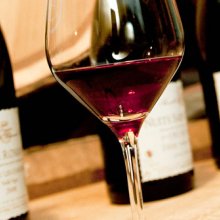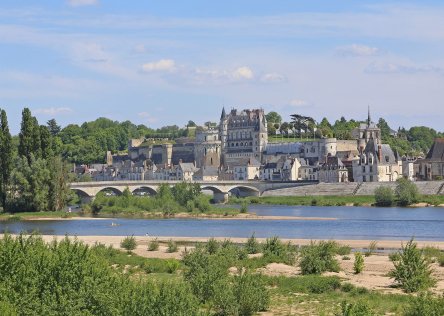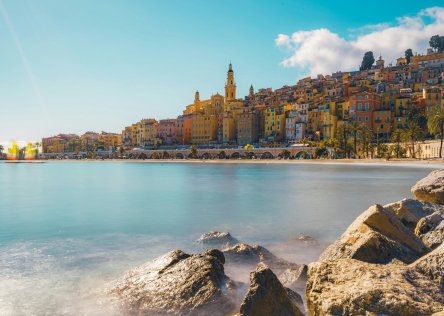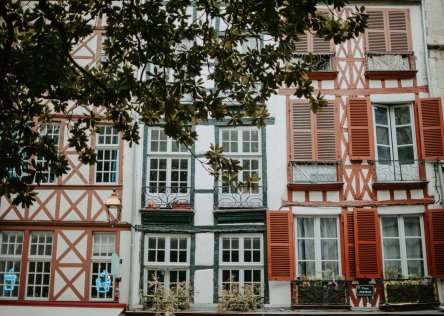A visit to Dijon, the capital of Burgundy : Places to see and things to do
by Laura Crotet, Senior Trip Planner at France Just For You
My husband Jean-François' whole family still lives in and around Dijon, so we go there every time we are on a family visit. It's a city that has greatly changed over the last few years. It has become more dynamic, lots of students give the town a good vibe, plus the historic and architectural elements have really been improved, making Dijon a great place to visit today.
The first time I came, Véronique, Jean-François’ oldest sister, insisted on taking me to rub the little owl carved into an outside wall of the Church of Notre Dame. It is said that if you touch it with your left hand, good luck will come your way.

You must rub the owl for good luck. ©OT Côte d'Or
This little owl has become the symbol of Dijon, and the best way to discover the city is on foot, following the Owl’s Trail (le Parcours de la Chouette). The walk is well-marked by brass plaques on the sidewalks and streets, and it will take you around all there is to see in downtown Dijon. You can buy a map at the tourist office (there is an app but it is not the best).
I’ve organized my favorite things to see and do in Dijon in the order of a nice walk, about 2 miles in total. Let’s go!
The Palais des Ducs de Bourgogne
I am a history nut, so of course this is on the top of my list. During the Middle Ages, the Dukes of Burgundy were more powerful than the king of France. Their control spanned central Europe, from Geneva to north of Amsterdam, and they left their marked in French history (they were the ones who turned Joan of Arc over to the English). They lived in the palace until 1477, when upon the death of Charles the Bold, Burgundy was attached to the French crown.

Charles the Bold, the last Duke of Burgundy
The Palais houses the Musée des Beaux-Arts, which opened to the public since 1799, making it one of the oldest museums in France. It has recently undergone a total renovation, plus entrance is free. The huge collection spans from medieval to contemporary, and you can see the extraordinary tombs of Philippe the Bold and Jean the Fearless in the Great Hall.
Rue Verrerie – medieval façades
This street is named for the glassmakers that used to be based here. Stroll down the street and admire the medieval façades (especially between n° 8 and n°12). The street is now filled with antique and decorating shops.
Maison Millière
Housed in a 15th century building, the Maison Millière was used for filming the Cyrano de Bergerac film starring Gérard Depardieu. It is a bar, tea shop, restaurant and boutique.
Church of Notre Dame
Don’t forget to touch the infamous little owl. On the way, check out the Hotel Vogüé (built in the early 17th century). And make a stop at La Mourtarderie Edmond Fallot to see all the different varieties of traditionally-made mustard.
Les Halles Market
The covered market is open on Tuesday, Friday and Saturday mornings, with a smaller market on Thursday morning. The charming building is often attributed to Gustave Eiffel (famous for designing the Eiffel Tower), but this is not correct as his plans did not get selected for the project. It was actually Louis-Clément Weinberger who designed the building.

It does look like an Eiffel, non? © France Just For You
Enjoy the lively local ambiance, and if it is not too busy, ask the vendors for a taste of whatever has caught your eye (especially the jambon persillé).
Mulot et Petitjean
At the cute historical boutique on Place Bossuet, you can taste one of my absolute favorite things to eat in Dijon – authentic pain d’épices. It translates to gingerbread, but I think it is so much better. Mulot et Pititjean have been making it for 220 years, and it’s the best. My mother-in-law Monique always gives me this as a gift because she knows how much I love it.

The best pain d'épices in the world! © France Just For You
Saint Bénigne Cathedral and Abbey
The Musée Archéologique is housed in the beautiful Saint Bénigne Abbey, which in and of itself is worth the visit. And it is once again free - I wish more towns would do this!
The adjacent cathedral was rebuilt in the 13th century. But the crypt underneath is one of the oldest Christian sanctuaries in France, and is still in the original layout.
The Botanical gardens
Part of the larger Parc de l’Arquebuse, the botanical gardens are a nice and refreshing escape from the city. It has been classed as an historical monument since 1964, and has a more scientific goal, along with the natural history museum and planetarium in the park.

The botanical garden in Dijon, © Christophe.Finot CC-BY-SA 3.0)
The Maille Mustard shop
Although nowadays Maille makes a more industrial-produced mustard, the shop is really nice. You can buy a pot (now you know why I like it), and have it filled up with the mustard of your choice.
Place François Rude and the Rue des Forges
In the middle of the place is the Bareuzai Fountain, referring to the man crushing grapes with his feet, resulting in the bottom of his legs becoming pink from the juice, or “bas rosé”.

The Bareuzai fountain, © France Just For You
The Rue des Forges leaves from the square and is lined with beautiful buildings.
The Philippe le Bon Tower
The tower is one of the oldest surviving sections of the Ducal palace. You will have to climb up 316 steps to get to the top, but the view is worth it. I have put this at the end because I recommend trying to do it just before sunset, and you will enjoy the twinkle of the city lights beginning to turn on.
On the weekends during high season, reserve in advance a special visit that ends with an aperitif on the top of the tour. What better way to end your visit of Dijon than toasting the city with a glass of famous Kir Royale with locally made crème de cassis?
Visit Dijon and other great places during a trip to Burgundy planned by France Just For You.












